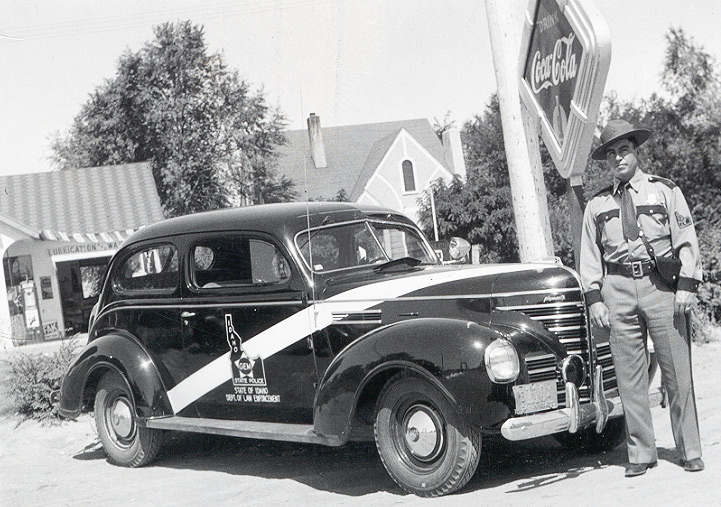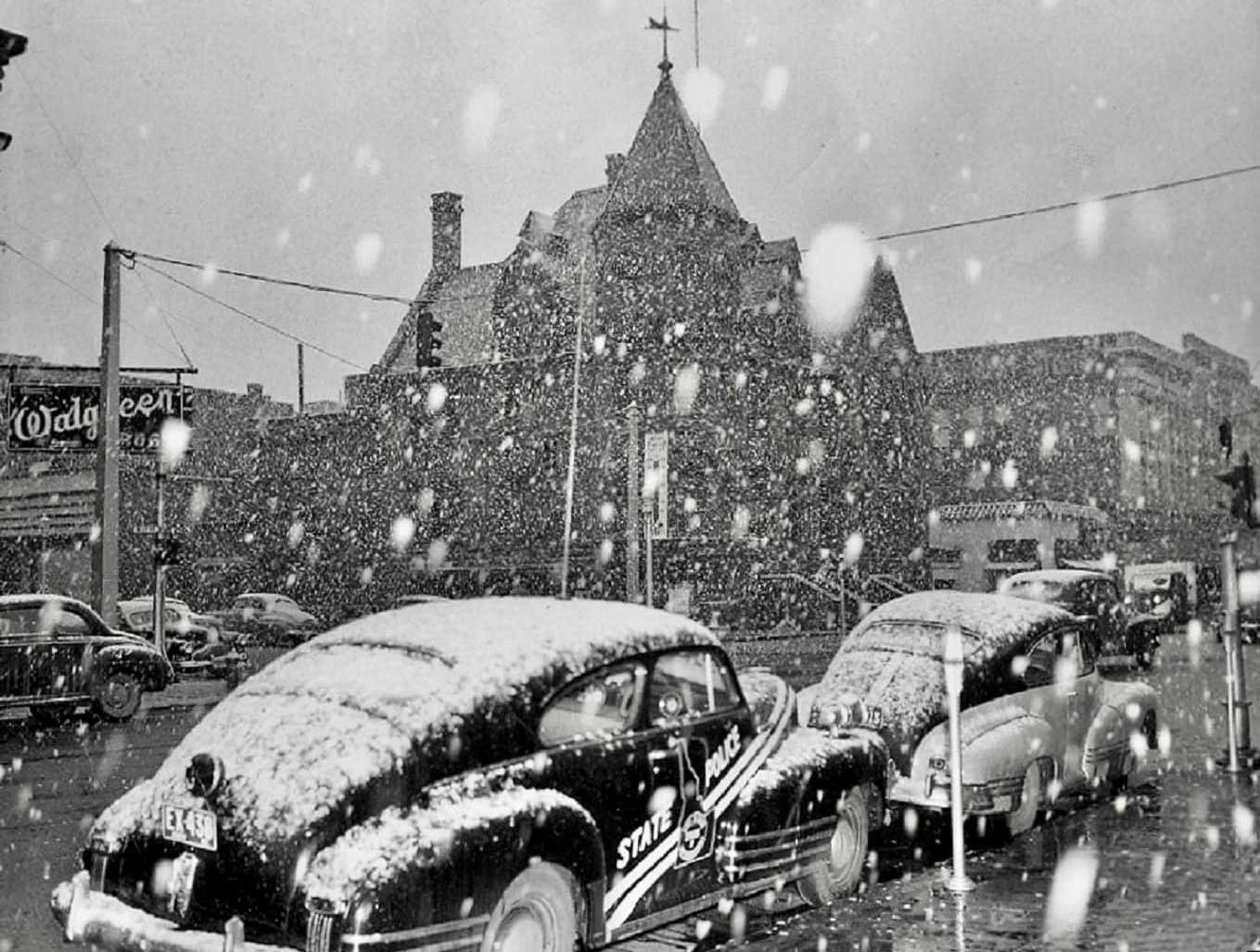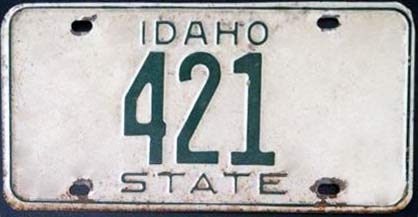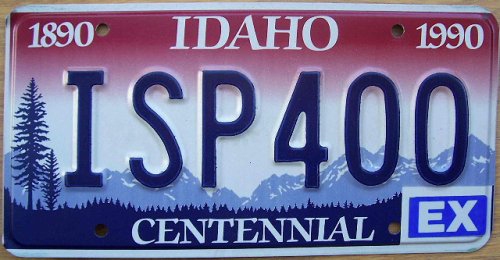Idaho State Police
Idaho State Police
The Bureau of Constabulary under the Idaho Department of Law Enforcement was established in May of 1919.
In March of 1929, the State Traffic Patrol was formed to address the matters of vehicular "high speed" on new asphalt roadways and the carnage that can sometimes come with it. By 1930, the fifteen man force collected auto license fees, set up light and brake testing stations, enforced spring highway load restrictions, suppressed gasoline bootleggers, kept irrigation water from eroding the highways and enforced all aircraft regulations as well! Their primary mandate however was to patrol the highways and reduce the collision rate.
By the end of 1930, over 2000 motorists on Idaho's highways were warned of traffic infractions and the most serious offenders found themselves in handcuffs. 21 Patrol Districts were set up and patrolled routinely. By 1938, US Route 95 known as the "North-South Highway" was completed and the need for stepped-up enforcement was required. In 1939, the Idaho State Police became the new name and organization that embodied the necessary authority to address all matters and manners of a state law enforcement mandate. In 1947, the Idaho State Police was up to 40 sworn officers and they received 40 new Chevrolet coupes with large diagonal stripes down both sides.
The birth of the "skunk car" as ISP marked patrol cars are known began. Strict enforcement of truck registration, weight and equipment laws by the Idaho State Police commenced with the "Port of Entry" program that went into full swing in 1952. This program alone required 25 officers to cover 44 counties to sustain it. The State Police became a separate division of the Department of Law Enforcement in 1955 and a superintendent appointed by the state governor became the man who administered and managed the agency. ISP marked patrol vehicles went to blue and white in 1965 and in 1978, they returned to the traditional black and white diagonal stripe. This was also the year that "bubble style" roof lights were replaced by light bars. In July of 1982, Port of Entry and Motor Vehicle Divisions were moved from the Department of Law Enforcement to the Idaho Transportation Department.
1983 saw delivery of twelve 5.0 liter Ford Mustangs for patrol. These 140 mph patrol cars required the specialized training of twelve lucky officers to manage the speed and handling of these hard-working vehicles. The ISP celebrated its 50th Anniversary on February 20 1989.
The Idaho State Police used exempt prefixed license plates for their marked patrol cars since their inception in 1929 when they were known as the Idaho Highway Patrol. The ISP had a reserved number bloc in the 400s which is still being used to this day, although the EX prefix was replaced by an ISP prefix in the 1970's. As the fleet grew, the reserved number bloc expanded into the 500 and 600 blocs as well.
 Once thought to be a first issue ISP license plate based on being an EXEMPT VEHICLE with a number in the 400 bloc.
Once thought to be a first issue ISP license plate based on being an EXEMPT VEHICLE with a number in the 400 bloc. 

 Boise Idaho- 1930. A gathering of Idaho State Police Officers with their Command Staff and cars. All cars bearing standard black over yellow-orange Idaho passenger license plates mostly in lower 200 series. Commander's Buick bearing number 2.
Boise Idaho- 1930. A gathering of Idaho State Police Officers with their Command Staff and cars. All cars bearing standard black over yellow-orange Idaho passenger license plates mostly in lower 200 series. Commander's Buick bearing number 2.1930 issue. Embossed steel. 5 1/2"x 12". Black over deep yellow. Exempt EX prefix followed by number in 400 bloc. 1930-IDAHO embossed along bottom.
 1931 issue. Embossed steel.
1931 issue. Embossed steel. 
1932 issue. Embossed steel. 6" x 12 1/2". Black over orange. Exempt identifier and number in 400 bloc.
 1933 "Combined Exempt" issue. Embossed steel. 6 1/4" x 13 1/2". Orange over black. Only one of this era without EX prefix. S infix instead. 19-IDAHO-33 embossed along bottom.
1933 "Combined Exempt" issue. Embossed steel. 6 1/4" x 13 1/2". Orange over black. Only one of this era without EX prefix. S infix instead. 19-IDAHO-33 embossed along bottom.
 1934 issue. Embossed steel.
1934 issue. Embossed steel. 
 1935 issue. Embossed steel.
1935 issue. Embossed steel. 
 1936 issue. Embossed steel.
1936 issue. Embossed steel. 
1937 issue. Embossed steel. 5 1/2" x 12". Black over silver. Exempt E prefix followed by number in 400 bloc followed by X suffix. STATE-37-IDA embossed along bottom center.
 1938 issue. Embossed steel.
1938 issue. Embossed steel.  1938 issue # 404
1938 issue # 404 1939 issue. Embossed steel.
1939 issue. Embossed steel. 

1940 issue. Embossed steel. 5 1/2" x 12". Green over Yellow-orange. Exempt E prefix followed by number in 400 bloc followed by X suffix. STATE-IDAHO-1940 embossed along bottom.
1941 issue. Embossed steel. 5 1/2" x 12". Black over yellow. STATE stacked vertically on left side of plate. Number in 400 bloc followed by IDAHO stacked vertically on right side of plate over EX-41 embossed in bottom center.
1942 issue. Embossed steel. 5 1/2" x 12". Blue over light gray. IDAHO 42 over small exempt EX prefix followed by number in 400 bloc.
1943 issue. No plate issued due to metal conservation for War effort. 1942 license plates revalidated for 1943 via 3 1/2" x 5 1/2" black and yellow windshield decal.
 1944 issue. No plate issued due to metal conservation efforts for War effort. 1942 license plate revalidated for 1944 via 2 3/4" x 4" black over cream windshield decal.
1944 issue. No plate issued due to metal conservation efforts for War effort. 1942 license plate revalidated for 1944 via 2 3/4" x 4" black over cream windshield decal.
1945 issue. Embossed steel. 5 1/2" x 12". Black over yellow-orange. Exempt EX prefix followed by number in 400 bloc over IDAHO 45.
1946 issue. Embossed steel. 5 1/2" x 12". White over black. Exempt EX prefix followed by number in 400 bloc over IDAHO 46.

 1948 Idaho Exempt license plate # EX- 438 (White over blue)
1948 Idaho Exempt license plate # EX- 438 (White over blue)
(Courtesy Kip Wills)
1948 issue. Embossed aluminum. 6 1/8" x 13". Black over aluminum. Idaho 48 over exempt EX prefix folllowed by number in 400 bloc.
1949 issue. Embossed aluminum validation tab. 1 1/4" x 1 7/8". Red over aluminum inserted into tab slits on either side of the 48 from the 1948 issue.
1950 issue. Embossed steel. 5 1/2" x 12". White over black. IDAHO 50 over exempt EX prefix followed by number in 400 bloc.
1951 issue. Embossed steel. 5 1/2" x 12". White over maroon. IDAHO 51 over number in 400 bloc.

 1951 issue
1951 issue 1952 issue. Embossed steel.
1952 issue. Embossed steel. 
 1952 STATE issue # 447 (White over maroon)
1952 STATE issue # 447 (White over maroon)From 1953 until the present day, all license plates used by the Idaho State Police measure the standard 6" x 12". Only color and formatting will be detailed in each type description.
1953-1955 issue. Embossed steel. White over black. IDAHO top left center over number in 400 bloc and STATE on bottom.
1955-1956 issue. Embossed steel. Black over white. IDAHO top left center over number in 400 bloc and STATE on bottom.
1957 issue. Embossed steel. White over light green. IDAHO 57 over number in 400 bloc and STATE on bottom.


1957 photo of Port of Entry scales at Idaho state line. ISP Port of Entry patrol car in light green instead of black. Photo courtesy of the late Earl Jenson as is the color photo above it showing the black 1956 Chevrolet with ISP plate # 453.
 1958 issue. Embossed steel.
1958 issue. Embossed steel. 
 1959 issue. Embossed steel.
1959 issue. Embossed steel. 
1960 issue. Embossed steel. Green over white. IDAHO 60 over number in 400 bloc and STATE on bottom.
 1961 issue. Embossed steel.
1961 issue. Embossed steel. 
1962 issue. Embossed steel. Green over white. IDAHO 62 over number in 400 bloc and STATE on bottom.
1963 issue. Embossed steel. White over green. IDAHO 63 over number in 400 bloc and STATE on bottom.
 1964 issue. Embossed steel.
1964 issue. Embossed steel. 
 1965 issue. Embossed steel.
1965 issue. Embossed steel. 
 1966-1967 issue. Embossed steel.
1966-1967 issue. Embossed steel. 
In 1968, Idaho decided to experiment with a variety of base license plates for motorists in the state (SIX variations in total!) and the State Police were part of the experimentation process with a number of different types used from 1968 until the next full license plate change-over in 1975.
Seen below are some of these variations.
 1968-1974 STATE issue using undated green over reflective white with sloppy application. These plates are often mistaken for "re-paints" due to the poor quality control before they were issued.
1968-1974 STATE issue using undated green over reflective white with sloppy application. These plates are often mistaken for "re-paints" due to the poor quality control before they were issued.
 1968-1974 STATE issue using undated green over reflective white with ridiculoulsy small and narrow dies for the state name, STATE and even the numerals. Barely legible from a distance.
1968-1974 STATE issue using undated green over reflective white with ridiculoulsy small and narrow dies for the state name, STATE and even the numerals. Barely legible from a distance.
 1973 DATED issue. Green over reflective white. Rare type and likely not used as Idaho State Police license plates were supposed to be undated as multi-year plates. This one is in mint condition and shows no signs of having been affixed for duty.
1973 DATED issue. Green over reflective white. Rare type and likely not used as Idaho State Police license plates were supposed to be undated as multi-year plates. This one is in mint condition and shows no signs of having been affixed for duty. 
 1968-1974 issue. Embossed aluminum.
1968-1974 issue. Embossed aluminum. 



 1940's ISP meets 1970's ISP
1940's ISP meets 1970's ISP 1975-1986 issue.
1975-1986 issue.  (Courtesy Preston Koening)
(Courtesy Preston Koening) 1975-1986 issue for the Peace Officer Standards and Training facility located in Meridien.
1975-1986 issue for the Peace Officer Standards and Training facility located in Meridien. 

In late 1985, the state of Idaho conducted a general "re-plate" of motor vehicles in the state. The plate was in green over reflective white and featured a stylized silkscreened top legend. The state name was in upper case font with the letter A done as a snow-capped mountain peak. A thin green line over a thick green line traverses from one end of the plate just below the upper mounting holes and beneath the state name. On the right side of the state name, the two lines continue to the right of the plate and then morph into jagged mountain silhouettes.
The bottom of the plate uses the same green line layout as the top portion, however in a straight uninterrupted line from one end of the plate to the other just below the bottom mounting holes. A rectangular outline occupies the lower right corner to accommodate validation decal
The earliest version of this plate used by the Idaho State Police had a seriffed I prefix letter followed by a number between 401 and 700. The word EXEMPT was embossed in green in the center bottom of the plate.
This plate proved to be highly unpopular with ISP Troopers. So much so, that by Spring of 1987 the preferred ISP prefix replaced the single letter I prefix on the same format.
 1986-1987 issue. Seriffed letter I prefix followed by number between 401 and 700. EXEMPT embossed on lower section. Unpopular government coded exempt plate used by ISP and used for barely one year as a result.
1986-1987 issue. Seriffed letter I prefix followed by number between 401 and 700. EXEMPT embossed on lower section. Unpopular government coded exempt plate used by ISP and used for barely one year as a result.
 Spring 1987 to December 1987 issue. Return of the ISP prefix and replacement of EXEMPT with STATE. Shortlived layout which was quickly replaced by the state centennial base plate described below. Rare type.
Spring 1987 to December 1987 issue. Return of the ISP prefix and replacement of EXEMPT with STATE. Shortlived layout which was quickly replaced by the state centennial base plate described below. Rare type. 
In 1987, Idaho was gearing-up to celebrate its centennial which was to take place in three short years. One of the initiatives to showcase the upcoming state 100 year celebration was to spearhead a general "re-plate" of all license plates in the state with a very special commemorative design. The new Idaho Centennial license plates were introduced to the motoring public and the ISP on January 1 1987. The top of the plate had a reflective red background with 1890 IDAHO 1990 in white. The red faded to white as it proceeded downward toward the center of the plate. In the reflective white field was a large and small pine tree in dark blue to the extreme left which continued into a coniferous forest in the same color across the lower center of the plate. Above the forest is a lighter blue and white mountain range. The lower portion of the plate comprises the forest foreground in dark blue with the word CENTENNIAL emblazoned in white between the lower mounting holes. A white rectangular void occupies the lower right corner to accommodate validation decals.
The Idaho State Police began using these plates at that time with the ISP prefix and a number from the 400 to 700 bloc.
The plates were "validated" at first by a white over blue reflective decal with EX inscribed. Later issues of this decal were dark blue over reflective white with EX inscribed. These plates were so popular that they continued to be used long after the state centennial in 1990.
In 1991, the years 1890 and 1990 were dropped from the top of the plate and replaced with the word Scenic in reflective white script in the upper left portion of the plate. The reflective white word CENTENNIAL on the bottom of the plate was replaced by the popular state motto FAMOUS POTATOES which has been used on regular Idaho license plates consistently since 1957.
The early version of the “Scenic” plate saw the two pine trees relocated to the right side of the plate over the validation decal area.
Around 1996, the larger pine trees were dropped from the design altogether.

 1987-1991 issue. State Centennial base.
1987-1991 issue. State Centennial base. 
 1987-1991 issue. State Centennial base.
1987-1991 issue. State Centennial base. 

 ISP Camaro (ISP 472)
ISP Camaro (ISP 472) 1991-2008 issue. Scenic base. Later type with larger pine trees no longer in place. Earlier version has the two larger pine trees to the RIGHT of the plate as seen in photo below of ISP Ford Crown Victoria number ISP 607.
1991-2008 issue. Scenic base. Later type with larger pine trees no longer in place. Earlier version has the two larger pine trees to the RIGHT of the plate as seen in photo below of ISP Ford Crown Victoria number ISP 607.



 2022 (ISP 495)
2022 (ISP 495) 1991-2008 issue. Sample.
1991-2008 issue. Sample.
 2008-Current issue. All-flat silkscreened type. Helix hologram down center of plate and UPC bar code below Exempt decal.
2008-Current issue. All-flat silkscreened type. Helix hologram down center of plate and UPC bar code below Exempt decal.  Service/Support vehicle.
Service/Support vehicle. ISP Mobile Command Center
ISP Mobile Command Center 2014- 75th Anniversary issue.
2014- 75th Anniversary issue.  75th Anniversary Souvenir type.
75th Anniversary Souvenir type.Motorcycle usage by the Idaho State Police began in 1931 and ended soon thereafter. In 1971, the ISP purchased five motorcycles for patrol, but were limited only to summer months. With an increase in injuries and other problems, motorcycle use was phased out by the end of summer 1982.
Only within the past few years has a resurgence of motorcycle use by ISP taken place.
It is unknown what kind of license plates were used on the earlier ISP motors. The newer motors bear a miniature version of the auto-sized license plate and use the same numbering format.
 Late 1970's Idaho SP Cowboy Motorman
Late 1970's Idaho SP Cowboy Motorman 2008-current motorcycle issue.
2008-current motorcycle issue. ISP motorcycle bearing plate # ISP 468
ISP motorcycle bearing plate # ISP 468